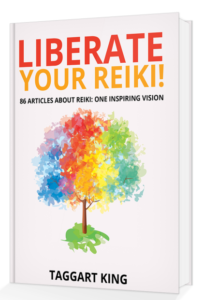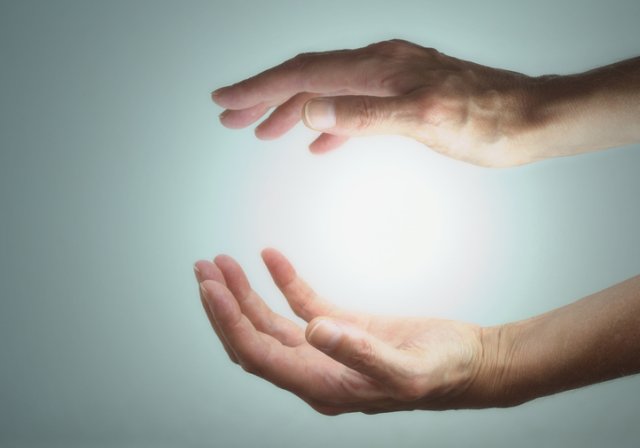In this article I would like to talk about the sort of things that students might feel – or not feel – when receiving attunements or empowerments, when working with energy and when treating or being treated, and the significance of these sensations.
The article is particular addressed to people who have just taken a First Degree course or who are only just starting on their journey with Reiki, though it should be of interest to people at all Reiki levels.
Reiki Attunements or Empowerments
(Please note that, to avoid unnecessary repetition, I am going to use the word ‘empowerment’ to refer both to Reiju empowerments and Western-style Reiki attunements.) They achieve the same thing anyway!
When we arrive on a Reiki First Degree course, we probably have very little idea of what we might experience when going through an empowerment. If you read books about Reiki, everyone seems to be going through an exceptional, once-in-a-lifetime experience, but for most people it really isn’t like that.
There is no way of predicting what an individual will experience when receiving an empowerment, whether in person or at a distance. You may have an amazing experience, or you may feel very little or nothing. It is not uncommon for people to see some colours or feel some heat or tingling or pulsing or pressure in various areas of their bodies.
For some people an empowerment is a unique experience, profound, emotional, an experience that is almost unbelievable.
For others very little seems to happen.
Sometimes you might find that there will be four people, say, on a course. Three people are talking about the surprising, or interesting, or special experiences that they just had, and one poor soul is sitting there thinking to themselves “I knew this wouldn’t work for me… I know Reiki is supposed to work for everyone, but it hasn’t worked for me”.
We assume that if we notice a lot happening then the empowerment has ‘taken’, that it has worked really well, and we assume that if we felt very little – or if we felt nothing – then the connection ritual has not worked, that we haven’t been attuned, or we haven’t been attuned properly.
But what a student experiences when they receive an empowerment is no guide as to the effectiveness of that empowerment. In fact what a student experiences really is irrelevant, because empowerments always work.
Of course it is nice and reassuring to have the “bells and whistles and fireworks” – it helps you to believe that something definite has happened – but someone who has noticed all these things has not been more effectively empowered when compared with a student who felt very little or nothing.
Experiences are interesting, but not important.
They don’t mean anything in terms of whether, or how well, an empowerment has worked, because empowerments always work, no matter what the student feels or doesn’t feel.
Experiencing Reiki energy when you treat someone
People are all different, and people differ in terms of how sensitive they are to the flow of energy in the early stages of their work with Reiki. Sometimes people arrive on a Reiki course massively sensitive to the energy, and perhaps better able to sense subtle differences than is their teacher, and that’s nice for them, while other people may notice something very subtle, or perhaps nothing at all.
Most people will feel something.
So when playing with energy, most people will feel something in between their hands when they try to make an energy ball. Most people will feel something when they try to feel someone else’s energy field, or if they practise ‘scanning’ (assuming that there is something there to detect – there won’t always be).
But not everyone will feel these things to begin with, and the people who do not feel anything should not be disheartened: because sensitivity to such things can develop with practice and repetition. Most people will find that, no matter how sensitive they find themselves when they first learn Reiki, when they start to work with the energy regularly – for example by carrying out Hatsurei ho every day, and by self-treating – their sensitivity to the energy will increase.
But this is a work-in-progress and we may need to be patient. And we may find that our sensitivity to the energy never reaches our goal, or is never as great as other Reiki people that we come across.
Maybe we are setting an unreasonable target for ourselves.
And we should remember that sensitivity to the flow of energy is not the be-all and end-all of Reiki. We can work on ourselves and derive the many benefits that come through Reiki, no matter what we feel or don’t feel when we carry out hatsurei ho or self-treat.
 We can treat other people effectively no matter what we might feel or not feel in our hands. I have come across several successful and effective Reiki Master / Teachers who do not feel anything going on in their hands, and never have done. The reason why they continued their Reiki training, rather than giving up in the face of no physical sensations to encourage them, was because they practised on lots of people and they could see, by the positive responses they received from the recipients, that something was definitely going on, that they were doing good things, that Reiki was certainly doing something for the people they treated even though they couldn’t feel the energy.
We can treat other people effectively no matter what we might feel or not feel in our hands. I have come across several successful and effective Reiki Master / Teachers who do not feel anything going on in their hands, and never have done. The reason why they continued their Reiki training, rather than giving up in the face of no physical sensations to encourage them, was because they practised on lots of people and they could see, by the positive responses they received from the recipients, that something was definitely going on, that they were doing good things, that Reiki was certainly doing something for the people they treated even though they couldn’t feel the energy.
You may ask how you can treat someone when you can’t feel anything, or if you can’t scan very well at the moment. Well, most people in the world of Reiki are taught a standard set of hand positions to use when they treat, and these standard positions can be followed, giving general coverage over the body; the energy is drawn to areas of need, so that works perfectly well.
Not everyone scans. Not everyone is taught how to scan. It isn’t a vital step in a treatment, but it can be a useful one to perform if you can do it.
But if you can work intuitively then of course you can place your hands in the right places for each person you work on, and stay in each position for the most appropriate amount of time, not based on the sensations you are feeling in your hands but based on your intuitive impressions.
Everyone can work intuitively with some practice, and you may well be taught how to carry out “Reiji ho” (a Japanese method for opening to your intuition during a treatment) on one of our Reiki Second Degree courses.
So an intuitive approach to treatments actually eliminates any advantage in being able to sense strongly in your hands.
Reiki sensations experienced by people you treat
Now, you will not be surprised to know that the experiences of people being treated also varies a great deal.
For some people, on some occasions, treatments are very strong. They might feel intense heat from the practitioner’s hands, see coloured lights, drift in and out of consciousness. And on other occasions that same person might feel the treatment to be mild and gentle.
The energy is drawn by the recipient in amounts that are appropriate for them on that occasion, so the perceived ‘strength’ of any treatment is determined by the recipient’s need.
The practitioner is just a necessary bystander in the treatment process.
While some people seem to quite often notice a lot happening when they are treated, there are also people who feel very little or nothing when they receive a Reiki treatment, no matter who they receive the treatment from. If you have just started out on your Reiki journey and you just happen to treat one of these people, or a few of these people, as your first ‘clients’ then you may end up disheartened, thinking that their lack of a strong sensation means that you are ineffective as a practitioner.
We want the recipient to feel a lot because that reassures us that we are doing things ‘correctly’, that we are effective as a channel for the energy.
But things aren’t always so simple: while quite often there may be general correlation between what the practitioner feels and what the recipient feels (a very hot area for the practitioner is felt as a very tingly area, say, for the recipient) this correlation will not always be there and, sometimes, you might find a practitioner feeling a raging furnace in their hands, amazed at the strength of what is going on, while the recipient did not notice anything at all, and perhaps didn’t notice anything at all during the entire treatment!
Summary
So really this whole article boils down to one simple phrase: “just for today, do not worry”.
While it is perfectly natural to want to have some physical sensations to help us believe that we are really doing something when we use Reiki on ourselves and on other people, and while most people who learn Reiki will receive sufficient feedback to reassure them, this will not always happen.
With practice and experience we start to let go of the need to be reassured by what we and others feel, and we come to realise that no matter what we feel or don’t feel, Reiki is working for us. But it can be difficult to accept this in the early stages, particularly if we are a little sceptical.
If you aren’t feeling too much at the moment my advice to you is to follow the instructions you were given: carry out your Hatsurei ho every day, self-treat regularly, and get your hands on as many people as you can.
Do short blasts on someone’s knee or shoulder, treat people in a straight-backed chair for 20-30 minutes, do full treatments; go with the time you have you have available.
The important thing is to get the hands-on practice and you will find, if you treat a good cross-section of people, that you will receive from them the positive feedback that you need, and with sufficient practice you may find that you start to notice more with time.
So be patient, don’t worry, and have fun with your Reiki.
Did you like this blog?
If so, you are going to love this book…

“Whether you are at Level 1, 2 or Reiki Master Teacher Level (regardless of the Reiki flavour you are trained in), this book is very much for you! Within hours of starting to read this book, it has rejuvenated and enriched my own practices with a wealth of information and useful examples too.
The more you read the more you’ll have those wonderful ‘aha’ moments. I know I am already benefiting personally from the knowledge I’ve gained, but so will all my family, friends and clients too. Thank you Taggart for creating this incredible, uniting, enlightening book.”
Heidi Gaffney-Evans
Liberate Your Reiki!
86 Articles About Reiki: One Inspiring Vision
In this Reiki book you will find 80+ articles about Reiki, written by Reiki Master Teacher Taggart King. You will discover how to set your Reiki free, free from the constraints, dogma, rules and regulations of Western-style Reiki courses. Get back to Reiki’s original Japanese method and embrace simplicity, flexibility, creativity and intuition.
This book is suitable for people at all Reiki levels: beginners, those who are developing their Reiki, and Reiki Masters/Master Teachers. You will find advice about self-treatment meditations, energy exercises to build your ability as a channel, you will discover how to work with your intuition and embrace the power of intent.
Explore different distant healing methods and discover the beauty of Reiki’s original Japanese form. Learn how to use creativity and visualisation to enhance your self-treatments and treatment of others, and ditch all the silly rules and regulations that stifle the practice of Western Reiki in many lineages.
Finally, read Taggart King’s “10 Rules of Reiki”, the essential principles for a powerful and fulfilling Reiki practice.
This professionally-printed Reiki manual has 370 A5 pages, a glossy soft cover and we will send it to anywhere in the world!
Read the contents list before you order, if you like, by clicking on this link: Table of contents
Book: 370 pages.
Price: £15.99 + p&p
![]()
Or Download a PDF version now for only £12.49
Author: Taggart King

